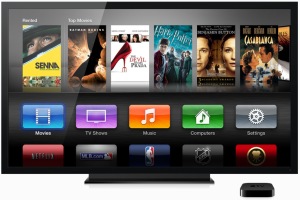First Look: Apple TV

With the previous generation stuck at 720p, many did not consider the previous generation of Apple TV to be a serious contender in the A/V stack. That changed with the most recent iteration of the device, and now that it supports 1080p output and playback — even full 1080p60 — we could have a serious contender for space in your living room. The unit just arrived earlier today, so this is just a first look with a much more detailed examination of the device to follow. Read on to get an idea of what the newest Apple TV provides.
Device
The packaging was uncharacteristically budget for an Apple device — most likely because of its relatively low price ($99). This is not to say the Apple TV was not well protected, or shabbily housed, just that on a relative scale it was not what I expected. To be clear I do not mean that as a knock — in fact the opposite is true. While overly sturdy and elaborate packaging enhances the unboxing experience it is also wasteful, both to the pocketbook and the planet. Before moving on, there were two things worth mentioning. First, the fantastic, wartless design of the power plug, and second the shock of not finding an HDMI cable in the box.
Lovers of the media stream puck popularized by devices like the Roku will love the Apple TV. In contrast to the Roku, it has a heft and solidity that makes the other device feel inexpensive, both with the remote and the device itself. The remote is pleasant to use, but I found the “Menu” button confusing as its function is actually “Back”; while reminiscent of the scroll wheel found on iPod devices the D-pad only functions like a traditional remote – a disappointment.
Settings
I was very pleased with the number and depth in the settings provided, with the ability to control audio bit depth, video color space, and IR learning provided to users. Of the three notable settings, color space is probably the most critical with other competing devices struggling to handle luminance correctly in a world of diverse hardware; it is refreshing to know that Apple has exposed the setting that will ensure proper levels for the myriad displays it could be connected to. While on this topic it should be mentioned that the Apple TV outputs blacker than black (BTB) and whiter than white (WTW) correctly in all three settings – YCbCr (4:4:4 8-bit), RGB High, and RGB Low, but BTB/WTW are clipped at 16 and 235 respectively. Unfortunately it appears that the Apple TV does not support HDMI CEC — which frankly, is shameful.
UI
There is no denying that the UI is visually appealing and functional, but I find that navigation often requires too many clicks to make substantive progress. Apple chose the same “less-is-more” approach as Boxee with its remote and suffers the same navigation constraints when it comes to more complex tasks; of course Boxee user can always flip their remotes over to deal with the truly complex, like entering usernames/passwords, but the Apple TV does make it easier in some places – for example it will prefill the Netflix login wizard with the iTunes email address.
Access to content is a weak spot for the device to anyone not convinced of the intrinsic value of iTunes for non-Netflix TV and movies. Although, if you do not mind pre-converting files streaming H.264 in MP4 works quite well from a “Home Sharing” enabled PC, including 1080p60. Music can also be streamed from the same PC, so if that capability is present on the network the overall experience is quite good – at least in comparison with DLNA.
Final Thoughts
Obviously more time will need to be spent with the Apple TV to fully probe its strengths and weaknesses, but it on first impression it is clear that the media streamer provides an excellent A/V device for those entrenched in the Apple lifestyle. Limited codec support, application variety, the lack of HDMI CEC, and price versus devices with more channels, flexibility, or both, handicap the streamer in a very competitive market.

If it works OK with wireless
If it works OK with wireless should I also connect the ethernet? Can it use both at the same time?
I haven’t had a chance to
I haven’t had a chance to test wireless v. wired performance in a meaningful way, but I would expect 802.11 N to be plenty for almost anything that the device is capable of. Wired is generally only necessary for very large files (like BD rips).